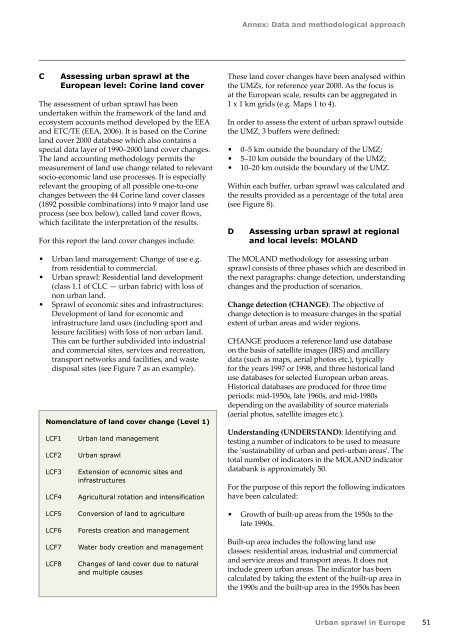Session 1 - Montefiore
Session 1 - Montefiore
Session 1 - Montefiore
You also want an ePaper? Increase the reach of your titles
YUMPU automatically turns print PDFs into web optimized ePapers that Google loves.
C Assessing urban sprawl at the<br />
European level: Corine land cover<br />
The assessment of urban sprawl has been<br />
undertaken within the framework of the land and<br />
ecosystem accounts method developed by the EEA<br />
and ETC/TE (EEA, 2006). It is based on the Corine<br />
land cover 2000 database which also contains a<br />
special data layer of 1990–2000 land cover changes.<br />
The land accounting methodology permits the<br />
measurement of land use change related to relevant<br />
socio-economic land use processes. It is especially<br />
relevant the grouping of all possible one-to-one<br />
changes between the 44 Corine land cover classes<br />
(1892 possible combinations) into 9 major land use<br />
process (see box below), called land cover flows,<br />
which facilitate the interpretation of the results.<br />
For this report the land cover changes include:<br />
• Urban land management: Change of use e.g.<br />
from residential to commercial.<br />
• Urban sprawl: Residential land development<br />
(class 1.1 of CLC — urban fabric) with loss of<br />
non urban land.<br />
• Sprawl of economic sites and infrastructures:<br />
Development of land for economic and<br />
infrastructure land uses (including sport and<br />
leisure facilities) with loss of non urban land.<br />
This can be further subdivided into industrial<br />
and commercial sites, services and recreation,<br />
transport networks and facilities, and waste<br />
disposal sites (see Figure 7 as an example).<br />
Nomenclature of land cover change (Level 1)<br />
LCF1 Urban land management<br />
LCF2 Urban sprawl<br />
LCF3 Extension of economic sites and<br />
infrastructures<br />
LCF4 Agricultural rotation and intensification<br />
LCF5 Conversion of land to agriculture<br />
LCF6 Forests creation and management<br />
LCF7 Water body creation and management<br />
LCF8 Changes of land cover due to natural<br />
and multiple causes<br />
Annex: Data and methodological approach<br />
These land cover changes have been analysed within<br />
the UMZs, for reference year 2000. As the focus is<br />
at the European scale, results can be aggregated in<br />
1 x 1 km grids (e.g. Maps 1 to 4).<br />
In order to assess the extent of urban sprawl outside<br />
the UMZ, 3 buffers were defined:<br />
• 0–5 km outside the boundary of the UMZ;<br />
• 5–10 km outside the boundary of the UMZ;<br />
• 10–20 km outside the boundary of the UMZ.<br />
Within each buffer, urban sprawl was calculated and<br />
the results provided as a percentage of the total area<br />
(see Figure 8).<br />
D Assessing urban sprawl at regional<br />
and local levels: MOLAND<br />
The MOLAND methodology for assessing urban<br />
sprawl consists of three phases which are described in<br />
the next paragraphs: change detection, understanding<br />
changes and the production of scenarios.<br />
Change detection (CHANGE): The objective of<br />
change detection is to measure changes in the spatial<br />
extent of urban areas and wider regions.<br />
CHANGE produces a reference land use database<br />
on the basis of satellite images (IRS) and ancillary<br />
data (such as maps, aerial photos etc.), typically<br />
for the years 1997 or 1998, and three historical land<br />
use databases for selected European urban areas.<br />
Historical databases are produced for three time<br />
periods: mid-1950s, late 1960s, and mid-1980s<br />
depending on the availability of source materials<br />
(aerial photos, satellite images etc.).<br />
Understanding (UNDERSTAND): Identifying and<br />
testing a number of indicators to be used to measure<br />
the 'sustainability of urban and peri-urban areas'. The<br />
total number of indicators in the MOLAND indicator<br />
databank is approximately 50.<br />
For the purpose of this report the following indicators<br />
have been calculated:<br />
• Growth of built-up areas from the 1950s to the<br />
late 1990s.<br />
Built-up area includes the following land use<br />
classes: residential areas, industrial and commercial<br />
and service areas and transport areas. It does not<br />
include green urban areas. The indicator has been<br />
calculated by taking the extent of the built-up area in<br />
the 1990s and the built-up area in the 1950s has been<br />
Urban sprawl in Europe 51











